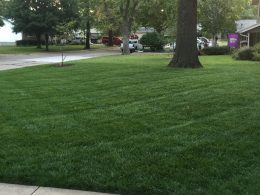 Fall is a great time to plant, over seed, core-aerate, power rake and fertilize tall fescue so to continue on the topic of lawns, what are the benefits of grass? Continue reading “Turfgrass Benefits”
Fall is a great time to plant, over seed, core-aerate, power rake and fertilize tall fescue so to continue on the topic of lawns, what are the benefits of grass? Continue reading “Turfgrass Benefits”
 Fall is a great time to plant, over seed, core-aerate, power rake and fertilize tall fescue so to continue on the topic of lawns, what are the benefits of grass? Continue reading “Turfgrass Benefits”
Fall is a great time to plant, over seed, core-aerate, power rake and fertilize tall fescue so to continue on the topic of lawns, what are the benefits of grass? Continue reading “Turfgrass Benefits”
If you have weeds in your lawn there are many reasons why! The following list are common problems lawn owners can have in Kansas:
Improper mowing.
Mowing too low and too infrequently thins the turf, allowing weeds to get started. Continue reading “Weeds in Lawn?”
Oh the chores of owning a lawn! Most homeowners in Harvey County have tall fescue lawns. Fescue differs from buffalograss or Bermundagrass in that is grows best in the cool season of the year, thus it is known as a cool-season grass (along with perennial ryegrass and Kentucky Bluegrass) and stays greener for a longer period of time. Culturing it otherwise invites weed, disease and insect issues. The following is a calendar for turf-type tall fescue. Continue reading “Chores of Owning a Lawn”
Avoid watering established tall fescue or bluegrass lawns prematurely in the spring. Even well-established tall fescue or bluegrass lawns must be watered regularly throughout the growing season to keep them green and growing. Buffalo grass is the most drought-tolerant grass and often survives summers without regular watering. Bermudagrass and zoysiagrass without excessive thatch require less water during stressful summers than do cool-season species.
Avoid watering established tall fescue or bluegrass lawns prematurely in the spring. Generally, there is a good reservoir of soil moisture remaining after winter, and during cooler springtime weather, grass plants require less water. Unnecessary irrigation can contribute to a shallow root system as summer approaches. Continue reading “Hold the Water!”